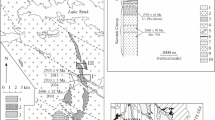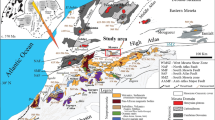Abstract
The Zapolyarnyi volcanic center is confined to the boundary between the oldest volcanic formations (I and II) of the Pechenga complex. Its structure and rock association are significantly different from those of numerous eruptive centers of areal basaltic volcanism in the Pechenga structure. It is an oval-shaped body, 700 × 300 m in size, composed of volcanic eruptive lava breccia. The clastic material of the breccia includes angular and partially molten fragments of granites, pegmatoid granites, epidosites, quartz, and feldspars embedded in basaltic lava. The basalts are titanium-rich and iron-rich varieties enriched in large-ion lithophile elements (Rb, Ba, and Sr); they are similar in composition, including Rb-Sr and Sm-Nd isotopic characteristics, to the ferropicrites of the youngest volcanic formation (IV) and their differentiation products. The basalts of the volcanic center show εNd(T) values from −3.13 to −1.17. In general, these rocks definitely represent the vent facies of an Early Proterozoic central-type volcano. The age of the basalt of the volcanic center is 1918 ± 3 Ma (U-Pb method on zircon) and is similar to the previously determined age of volcanics of volcanic formation IV (1990 ± 40 Ma, Sm-Nd method). The rocks of this formation participated 2000–1900 Ma ago in the formation of the volcanoplutonic ore-bearing ferropicrite-gabbro-wehrlite association of the Pechenga structure. The age of the ore-bearing Pilguyarvi gabbro-wehrlite intrusion was constrained between 1987 ± 5 Ma (U-Pb method on zircon) and 1980 ± 10 Ma (U-Pb method on baddeleyite). In addition, the first data were obtained for the age of comagmatic olivine norites of the Nyasyucka dike complex in the northeastern flank of the Pechenga structure (1941 ± 3 Ma, U-Pb method on baddeleyite) and the peridotites of the Allarechka ore field in the southern framing of the Pechenga structure (1918 ± 29 Ma, U-Pb method on zircon), which were previously considered Archean. Taking into account the geological and geochemical characteristics of the rocks of the Zapolyarnyi paleovolcano and the identical age of the Ludikovian intrusions, it can be concluded that the basalts of the paleovolcano were formed during late stages of the evolution of Early Proterozoic basic-ultrabasic magmatism, which was characterized by extensive explosive activity and strong magmatic differentiation responsible for the generation of the ore-bearing intrusions of the ferropicrite-gabbro-wehrlite association.
Similar content being viewed by others
References
Yu. A. Balashov, “Paleoproterozoic Geochronology of the Pechenga-Varzuga Structure, Kola Peninsula,” Petrologiya 4, 3–25 (1996) [Petrology 4, 1–22 (1996)].
T. B. Bayanova, Candidate’s Dissertation in Geology and Mineralogy (Inst. Litol. Ross. Akad. Nauk, Moscow, 1992).
T. B. Bayanova, Age of Reference Geological Complexes of the Kola Region and Duration of Magmatic Processes (Nauka, St. Petersburg, 2004) [in Russian].
T. B. Bayanova, V. F. Smolkin, N. V. Levkovich, and G. I. Ryungenen, “U-Pb Age of Rocks of the Mt. General’skaya Layered Intrusion, Kola Peninsula,” Geokhimiya, No. 1, 3–13 (1999) [Geochem. Int. 37, 1–10 (1999)].
Zh. A. Fedotov, “Dacitic Porphyries and Quartz Porphyries in the Diabase Volcanogenic Formation of Pechenga,” in Nature and Economy of the North. Proceedings of 2nd Scientific Conference of the Northern Branch of the Geographical Union of the USSR (Apatity, 1971), pp. 55–60 [in Russian].
E. J. Hanski, “Petrology of the Pechenga Ferropicrites and Cogenetic Ni-Bearing Gabbro-Wehrlite Intrusions, Kola Peninsula, Russia. Academic Dissertation,” Geol. Surv. Finl. Bull. 367 (1992).
H. Huhma, V. F. Smolkin, and E. J. Hanski, “Sm-Nd Isotope Study of the Nyasyukka Dyke Complex in the Northern Pechenga Area, Kola Peninsula, Russia,” in Abstracts of IGCP Project 336 Symposium, Rovaniemi, Finland, 1996 (Rovaniemi, 1996), pp. 57–78.
E. V. Isanina, M. L. Verba, N. M. Ivanova, et al., “Deep Structure and Seismogeological Boundaries of the Pechenga District in the Baltic Shield and the Adjacent Part of the Barents Sea Shelf Plate,” Geol. Rudn. Mestorozhd. 42, 476–487 (2000) [Geol. Ore Dep. 42, 429–439 (2000)].
S. B. Jacobsen and G. J. Wasserburg, “Sm-Nd Isotopic Evolution of Chondrites and Achondrites, II,” Earth Planet. Sci. Lett. 67, 137–150 (1984).
V. I. Kazansky, E. V. Isanina, K. V. Lobanov, et al., “Geological-Geophysical Setting, Seismogeological Boundaries, and Metallogeny of the Pechenga Ore District,” Geol. Rudn. Mestorozhd. 44, 276–286 (2002) [Geol. Ore Dep. 44, 242–251 (2002)].
A. Kontinen, “An Early Proterozoic Ophiolite—the Jormua Mafic-Ultramaphic Complex, Northeastern Finland,” Precambrian Res. 35, 313–341 (1987).
A. G. Krill, S. Bergh, and I. Lindahl, “U-Pb and Sm-Nd Isotopic Data from Precambrian Rocks of Finnmark,” Bull. Nor. Geol. Unders. 403, 37–54 (1985).
T. E. Krogh, “A Low-Contamination Method for Hydrothermal Dissolution of Zircon and Extraction of U and Pb for Isotopic Age Determinations,” Geochim. Cosmochim. Acta 37, 485–494 (1973).
R. Lahtinen and H. Huhma, “Isotopic and Geochemical Constraints on the Evolution of the 1.93–1.79 Ga Svecofennian Crust and Mantle in Finland,” Precambrian Res. 82, 13–34 (1997).
K. R. Ludwig, “PBDAT—A Computer Program for Processing Pb-U-Th Isotope Data. Version 1.22,” US Geol. Surv. Open-File Report, No. 88-542 (1991).
K. R. Ludwig, “Using ISOPLOT/Ex. Version 2.05: A Geochronological Toolkit for Microsoft Excel,” Berkeley Geochronol. Center, Spec. Publ., No. 1a (1999).
Magmatism, Sedimentogenesis, and Geodynamics of the Pechenga Paleorift Structure, Ed. by F. P. Mitrofanov and V. F. Smolkin (Kol. Fil. RAN, Apatity, 1995) [in Russian].
A. A. Marakushev, N. I. Bezmen, P. K. Skuf’in, and V. F. Smolkin, “Layered Ni-Bearing Intrusions and Volcanic Series of Pechenga,” Ocherki Fiz.-Khim. Petrol. 12, 39–63 (1984).
V. A. Melezhik, K. A. Hudson-Edwards, P. K. Skuf’in, and L.-P. Nilson, “Pechenga Area, Russia. Part 1: Geological Setting and Comparison with Pasvik, Norway,” Trans. Inst. Mineral. Metall. Sect. B: Appl. Earth Sci. 103, 129–145 (1994a).
V. A. Melezhik, K. A. Hudson-Edwards, A. H. Green, and L. N. Grinenko, “Pechenga Area, Russia. Part 2: Nickel-Copper Deposits and Related Rocks,” Trans. Inst. Mineral. Metall. Sect. B: Appl. Earth Sci. 103, 146–161 (1994b).
D. D. Mirskaya, “Vent and Subvoclanic Rocks of the Pechenga Group,” in Problems of Precambrian Sedimentary Geology (Nedra, Leningrad, 1971), Issue 3, pp. 49–56 [in Russian].
F. P. Mitrofanov and T. B. Bayanova, “Duration and Timing of Ore-Bearing Paleoproterozoic Intrusions of Kola Province,” in Mineral Deposits: Processes and Processing, Ed. by C. Stanely, et al. (Balkema, Rotterdam, 1999), Vol. 2, 1275–1278 (1999).
L. L. Perchuk and T. I. Frolova, “Reasons for the Diversity of Basaltic Series,” Izv. Akad. Nauk SSSR, Ser. Geol., No. 8, 28–44 (1979).
A. A. Predovskii, Zh. A. Fedotov, and A. M. Akhmedov, Geochemistry of the Pechenga Complex (Metamorphosed Sediments and Volcanic Rocks) (Nauka, Leningrad, 1974) [in Russian].
A. A. Predovskii, V. A. Melezhik, V. I. Bolotov, et al., Volcanism and Sedimentogenesis in the Precambrian of the Northeastern Baltic Shield (Nauka, Leningrad, 1987) [in Russian].
I. S. Puchtel, D. Z. Zhuravlev, V. S. Kulikov, and V. V. Kulikova, “Petrography and Sm-Nd Age of a Differentiated Flow of Komatiitic Basalts of the Vetreny Belt (Baltic Shield),” Geokhimiya, No. 5, 625–635 (1991).
Yu. D. Pushkarev, G. I. Ryungenen, V. F. Smolkin, and L. K. Shurkina, “Lead Isotope Geochemistry and Formation of the Ore-Forming Systems of the Ni-Bearing Mafic-Ultramafic Rocks of the Kola Peninsula,” in Isotope Geochemistry of Ore Formation (Nauka, Moscow, 1985), pp. 150–166 [in Russian].
P. K. Skuf’in, “Evolution of the Volcanism of the Ore-Bearing Pechenga Zone, Kola Peninsula,” Geol. Rudn. Mestorozhd. 35(3), 271–283 (1993).
P. K. Skuf’in, Doctoral Dissertation in Geology and Mineralogy (Mosk. Gos. Univ., Moscow, 1998).
P. K. Skuf’in and T. B. Bayanova, “U-Pb Age of a Paleoproterozoic Eruptive Center in the Pechenga Zone, Kola Peninsula,” in Proceedings of 2nd All-Russian Symposium on Volcanology and Paleovolcanology. Volcanism and Geodynamics, Yekaterinburg, Russia, 2003 (Inst. Geol. Geokhim. Ural. Otd. Ross. Akad. Nauk, Yekaterinburg, 2003), pp. 424–428 [in Russian].
P. K. Skuf’in and L. P. Nikolaeva, “Tectonics of the Core of the Pechenga Structure,” in Regional Tectonics of the Early Precambrian of the USSR (Nauka, Leningrad, 1980), pp. 80–87 [in Russian].
P. K. Skuf’in, T. B. Bayanova, F. P. Mitrofanov, et al., “The Absolute Age of Granitoids from the Shuoniyavri Pluton in the Southern Framework of the Pechenga Structure, the Kola Peninsula,” Dokl. Akad. Nauk 370, 227–230 (2000) [Dokl. Earth Sci. 370, 114–117 (2000)].
V. F. Smolkin, Komatiite and Picrite Magmatism of the Early Precambrian of the Baltic Shield (Nauka, St. Petersburg, 1992) [in Russian].
V. F. Smolkin, “Magmatism of the Early Proterozoic (2.5–1.7 Ga) Rift System in the Northwestern Baltic Shield,” Petrologiya 5, 394–411 (1997) [Petrology 5, 350–365 (1997)].
J. S. Stacey and J. D. Kramers, “Approximation of Terrestrial Lead Isotope Evolution by a Two-Stage Model,” Earth Planet. Sci. Lett. 26, 207–221 (1975).
R. H. Steiger and E. Jäger, “Subcommission on Geochronology: Convention on the Use of Decay Constants in Geo-and Cosmochronology,” Earth Planet. Sci. Lett. 36, 359–362 (1977).
V. R. Vetrin, Yu. D. Pushkarev, and G. I. Ryungenen, “Geologic Position and Age of Granitoids in the Southern Framing of Pechenga,” in Structure and Metamorphic Evolution of the Main Structural Zones of the Baltic Shield (KNTs AN SSSR, Apatity, 1987), pp. 83–93 [in Russian].
A. B. Vrevsky, R. Sh. Krymsky, and V. A. Matrenichev, “Structure and Evolution of Archean Mantle Plume: Evidence from Geochemical and Isotopic Composition of Komatiites of the Baltic Shield,” in Proceedings of 9th Meeting of the Association of European Geological Societies (MAEG). Precambrian of Europe, St. Petersburg, Russia, 1995 (IPGG RAS, St. Petersburg, 1995), p. 126.
R. Walker, J. W. Morgan, E. J. Hanski, and V. F. Smolkin, “The Role of the Re-Os System in the Study of Magmatic Sulfide Ores: A Tale of Three Ores,” in Proceedings of Sudbury-Norilsk Symposium, Ontario, Canada, 1994, Ontario Geol. Surv. Spec. Publ., No. 5, 343–355 (1994).
V. G. Zagorodnyi, D. D. Mirskaya, and S. N. Suslova, Geologic Structure of the Pechenga Sedimentary-Volcanogenic Series (Nauka, Moscow, 1964) [in Russian].
Author information
Authors and Affiliations
Additional information
Original Russian Text © P.K. Skuf’in, T.B. Bayanova, 2006, published in Petrologiya, 2006, Vol. 14, No. 6, pp. 649–669.
Rights and permissions
About this article
Cite this article
Skuf’in, P.K., Bayanova, T.B. Early Proterozoic central-type volcano in the Pechenga structure and its relation to the ore-bearing gabbro-wehrlite complex of the Kola Peninsula. Petrology 14, 609–627 (2006). https://doi.org/10.1134/S0869591106060063
Received:
Issue Date:
DOI: https://doi.org/10.1134/S0869591106060063




